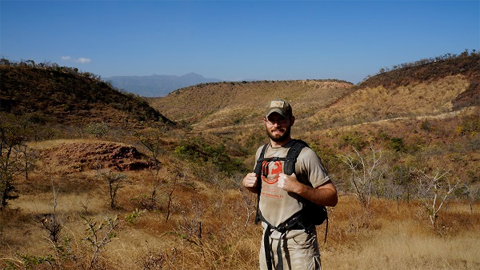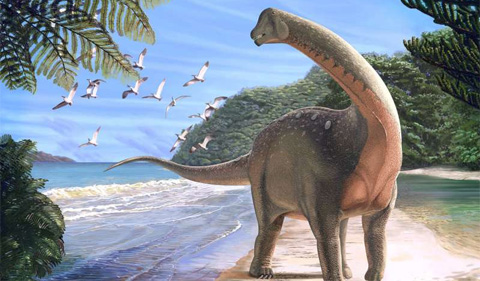
Eric Gorscak is a Cambridge, Ohio, native who earned a Ph.D. in biological sciences at Ohio University. Photo: Emily R. Naylor/Courtesy of Eric Gorscak
Editor’s Note: The Happy Beginnings series features recent College of Arts & Sciences graduates who are getting started in careers, graduate school and service.
Ohio University alum Eric Gorscak ’09, ’17Ph.D., who is now a post-doc research scientist at the Field Museum in Chicago, helped in the discovery of a new species of dinosaur in Africa—and it could help solve the mystery of what happened to the dinosaurs in Africa.
- Read Gorscak’s blog posts at the Field Museum, including “Tyrannosaur Relatives of SUE,” the famous T. rex on display there.
Gorscak earned a B.S. in Biological Sciences and just completed a Ph.D. in Biological Sciences from the College of Arts & Sciences.

Life reconstruction of the new titanosaurian dinosaur Mansourasaurus shahinae on a coastline in what is now the Western Desert of Egypt approximately 80 million years ago. Credit: Andrew McAfee, Carnegie Museum of Natural History
His work with Egyptian researchers was just featured at Phys.org in a story headlined “New Egyptian dinosaur reveals ancient link between Africa and Europe.”
When it comes to the final days of the dinosaurs, Africa is something of a blank page. Fossils found in Africa from the Late Cretaceous, the time period from 100 to 66 million years ago, are few and far between. That means that the course of dinosaur evolution in Africa has largely remained a mystery. But in the Sahara Desert of Egypt, scientists have discovered a new species of dinosaur that helps fill in those gaps: Mansourasaurus shahinae, a school-bus-length, long-necked plant-eater with bony plates embedded in its skin.
The fossilized remains of Mansourasaurus were unearthed by an expedition undertaken by the Mansoura University Vertebrate Paleontology (MUVP) initiative, an effort led by Dr. Hesham Sallam of the Department of Geology at Mansoura University in Mansoura, Egypt. Sallam is the lead author of the paper published today in the journal Nature Ecology and Evolution that names the new species….
“Mansourasaurus shahinae is a key new dinosaur species, and a critical discovery for Egyptian and African paleontology,” says Dr. Eric Gorscak, a postdoctoral research scientist at The Field Museum and a contributing author on the study. Gorscak, who began work on the project as a doctoral student at Ohio University, where his research focused on African dinosaurs, adds, “Africa remains a giant question mark in terms of land-dwelling animals at the end of the Age of Dinosaurs. Mansourasaurus helps us address longstanding questions about Africa’s fossil record and paleobiology—what animals were living there, and to what other species were these animals most closely related?”
Read the rest of the Phys.org story, “New Egyptian dinosaur reveals ancient link between Africa and Europe.”
Read the journal article, New Egyptian sauropod reveals Late Cretaceous dinosaur dispersal between Europe and Africa. , with Gorscak and Dr. Patrick O’Connor of Ohio University as co-authors.
Abtract: Prominent hypotheses advanced over the past two decades have sought to characterize the Late Cretaceous continental vertebrate palaeobiogeography of Gondwanan landmasses, but have proved difficult to test because terrestrial vertebrates from the final ~30 million years of the Mesozoic are extremely rare and fragmentary on continental Africa (including the then-conjoined Arabian Peninsula but excluding the island of Madagascar). Here we describe a new titanosaurian sauropod dinosaur, Mansourasaurus shahinae gen. et sp. nov., from the Upper Cretaceous (Campanian) Quseir Formation of the Dakhla Oasis of the Egyptian Western Desert. Represented by an associated partial skeleton that includes cranial elements, Mansourasaurus is the most completely preserved land-living vertebrate from the post-Cenomanian Cretaceous (~94–66 million years ago) of the African continent. Phylogenetic analyses demonstrate that Mansourasaurus is nested within a clade of penecontemporaneous titanosaurians from southern Europe and eastern Asia, thereby providing the first unambiguous evidence for a post-Cenomanian Cretaceous continental vertebrate clade that inhabited both Africa and Europe. The close relationship of Mansourasaurus to coeval Eurasian titanosaurians indicates that terrestrial vertebrate dispersal occurred between Eurasia and northern Africa after the tectonic separation of the latter from South America ~100 million years ago. These findings counter hypotheses that dinosaur faunas of the African mainland were completely isolated during the post-Cenomanian Cretaceous.



















Comments